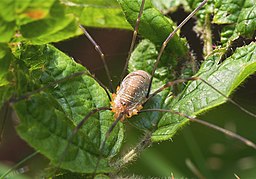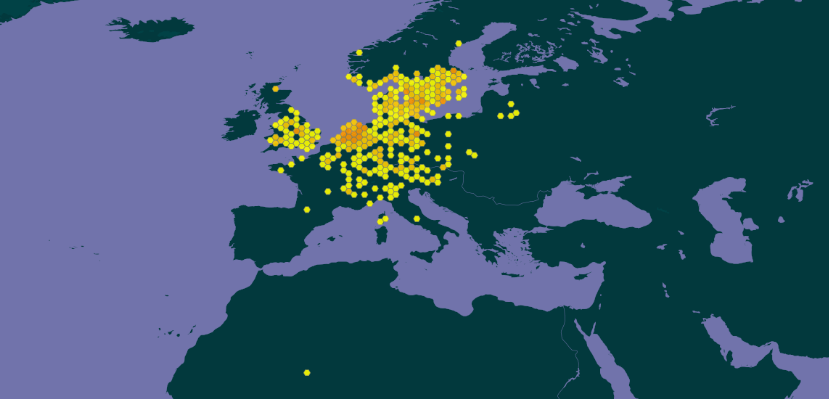 |
n/a | Status LU: established. 1st record: 2009. |
 |
Roude Schneider | Status Eur.: established. |
 |
n/a | RA: ISEIA: B3, Watch List. Harmonia+: n/a. |
 |
Apenninen-Kanker | Wikipedia:    | Wikispecies: n/a (2020) | CABI | Wikispecies: n/a (2020) | CABI |
 |
Rode hooiwagen | Back to the list of invertebrates |
Contents
Report the species
→ Report Opilio canestrinii to the National Museum of Natural History.
Brief description
 Opilio canestrinii is a species of harvestman. Males reach a body length up to 6 mm, females up to 8 mm. While males are yellowish brown to reddish, females are lighter. Males have dark legs, but yellow coxae and “knees”; the legs of females show alternately light and dark rings. The backs of females sport a dark, saddle-like pattern with a light longitudinal stripe in the middle. Adults can be found from June to December.
Opilio canestrinii is a species of harvestman. Males reach a body length up to 6 mm, females up to 8 mm. While males are yellowish brown to reddish, females are lighter. Males have dark legs, but yellow coxae and “knees”; the legs of females show alternately light and dark rings. The backs of females sport a dark, saddle-like pattern with a light longitudinal stripe in the middle. Adults can be found from June to December.
O. canestrinii probably originates from Italy, but has invaded Central Europe since the late 1970, and has since almost everywhere replaced the similar O. parietinus. It is most often found on house walls (Wikipedia contributors 2019).
Status and distribution in Luxembourg
Records of Opilio canestrinii (Thorell, 1876) in Luxembourg. Data source: Recorder-Lux, iNaturalist & GBIF, 2025-12-07.
The first documented occurrence of the species in Luxembourg dates from 2009. It was found by C. Muster on 20th August 2009 in Fort Berlaimont (Municipality of Luxembourg).
Opilio canestrinii is the second most common harvestman in Luxembourg and can be found in every region of the country.
Opilio canestrinii colonises a number of open habitats independently of their moisture levels. It is very successful in man-made landscapes, even in bigger cities. It is a strong competitor to native species and seems able to displace or even replace them. There are indicators that the similar Opilio parietinus, traditionally a common species on house walls, has nearly vanished, just a few years after the arrival of O. canestrinii.
Several sources describe this harvestman as a typical species of urban areas. In Luxembourg however, the data provided from different projects show evidence that the species occurs in great numbers and important percentages even in close-to-nature areas. Since the 1960s, O. canestrinii has spread extremely quickly northwards through Europe and has become a more or less common species in their new areas.
Risk assessment
ISEIA protocol
B3 (3+2+3+1) = Watch List (Ries et al. 2017: 68).
Harmonia+ protocol
Not assessed yet.
Worldwide distribution
Bibliography
- CABI, 2019. Opilio canestrinii. In: Invasive Species Compendium. Wallingford, UK: CAB International. URL: www.cabi.org/isc [accessed 2020-03-05]
- GBIF, 2020. Opilio canestrinii in GBIF Secretariat (2019). GBIF Backbone Taxonomy. Checklist dataset https://doi.org/10.15468/39omei [accessed 2020-03-05]
- MNHNL, iNaturalist & GBIF, 2020. Opilio canestrinii in MNHNL-mdata, online portal combining species observation from Recorder-Lux, iNaturalist and GBIF. National Museum of Natural History, Luxembourg. URL: https://mdata.mnhn.lu [Accessed 2020-03-05]
- Muster, C. & M. Meyer, 2014. Verbreitungsatlas der Weberknechte des Großherzogtums Luxemburg. Ferrantia 70. Musée national d’histoire naturelle, Luxembourg, 112 S. (PDF 3.8 MB)
- Ries, C., A. Arendt, C. Braunert, S. Christian, A. Dohet, A. Frantz, G. Geimer, M. Hellers, J. A. Massard, X. Mestdagh, R. Proess, N. Schneider & M. Pfeiffenschneider, 2017. Environmental impact assessment and black, watch and alert list classification after the ISEIA Protocol of invertebrates in Luxembourg. Bull. Soc. Nat. luxemb. 119: 63-70. [PDF 360 KB]
- Weber, D. (Hrsg.), 2014. Die Höhlenfauna Luxemburgs. Ferrantia 69. Musée national d’histoire naturelle Luxembourg, 408 pp. + CD-Rom (PDF 19 MB)
- Wikipedia contributors, 2019. Opilio canestrinii. Wikipedia, The Free Encyclopedia, 17 January 2019, 10:39 UTC, <https://en.wikipedia.org/w/index.php?title=Opilio_canestrinii&oldid=878854172> [accessed 2020-03-05]
Suggested citation of this webpage
Ries, C. & M. Pfeiffenschneider (Eds.), 2025. Opilio canestrinii (Thorell, 1876). In: neobiota.lu - Invasive Alien Species in Luxembourg. National Museum of Natural History, Luxembourg. URL: https://neobiota.lu/opilio-canestrinii/ [Accessed 2025-12-07].
Page content last updated on 2021-05-14. Last proofread by Caroline Grounds on 2019-12-10.


